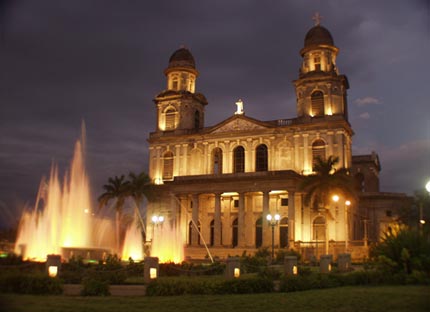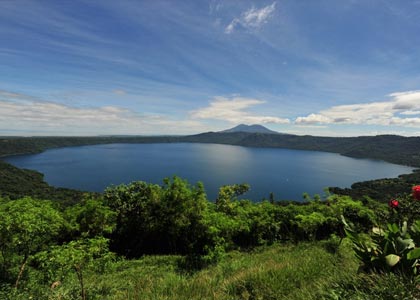Nicaragua
Country statistics

Land area: 46,430 sq miles (120,254 sq km)
Total area: 49,998 sq miles (129,494 sq km)
Population (2010 est.): 5,995,928 (growth rate: 1.7%); birth rate: 22.77/1000; infant mortality rate: 24.1/1000; life expectancy: 71.8; density per sq km: 48
Capital City: Managua
Monetary unit: Gold cordoba
Languages: Spanish 98% (official); English and indigenous languages on Atlantic coast (1995)
Ethnicity/race: mestizo 69%, white 17%, black 9%, Amerindian 5%
Religions: Roman Catholic 73%, Evangelical 15%, Moravian 2%, none 9% (1995)
Country introduction

Nicaragua is the largest country by area in Central America, bordering Honduras to the north and Costa Rica to the south. The Pacific Ocean lies to the west, and the Caribbean Sea to the east.
The country is divided into three geographic regions, the Pacific lowlands on the west, the mountainous central region and the Caribbean lowlands on the east.
The Pacific lowlands extend about 75 km (46 miles) inland from the Pacific coast. Most of the area is flat, except for a line of young volcanoes that run between the Gulf of Fonseca and Lake Nicaragua, many of which are still active. East of the volcanoes lies a large structural rift that has formed along a narrow depression south-eastward from Gulf of Fonseca. Two largest freshwater lakes in Central America (Lago de Managua and Lago de Nicaragua) are also located in the rift. This region is the most populated. About 27% of the nation's entire population lives in and around Managua, the capital city, on the southern shores of Lake Managua.
Between the Pacific lowlands and the Caribbean lowlands are the central highlands, which comprises a total area of 30% of the country and are most extensive in the north. The lowlands have many large coffee plantations and is ecologically the most active consisting of oaks, pines, moss, ferns and orchids in the massive cloud forests of the region. With ranges over 1000 m (3,281 ft), the region is mainly formed by mountain chains descending from the north to the south near the region of the San Juan River. One of these mountain chains is the Dariense, which extends to the coffee region of Matagalpa. Another important mountain chain is the Cordillera Chontaleña, which covers the cattle state of Chontales. A remarkable mountain is Mogotón that stands at 2,107 m (6,913 ft) and is located in the Natural Reserve Jalapa-Dipilto in Nueva Segovia, which is Nicaragua's highest peak.
The Caribbean lowland region covers about half of the country and consists of tropical rainforests and pine savannas crossed by numerous rivers flowing into the Caribbean Sea. The region is home to one of the largest rainforests in the America Continent, the Bosawás Biosphere Reserve. At approximately 20,000 sq km (2 million hectares) in size, the reserve comprises about 15% of the nation's total land area making it the second largest rainforest in the Western Hemisphere, after the Amazon in Brazil. A great variety of birds live in the tropical forests including eagles, turkeys, toucans, parakeets and macaws, while animal life in the area include several different species of monkeys, ant-eaters, white-tailed deers and tapirs.
The culture

People living near the western half of the country derived their culture from a mixture of the native Indians and the Spanish settlers of the 16th century. Consequently, many of the cities near here retained a strong Spanish influence and Catholicism became the dominant religion. However, those living near the eastern half of the country were influenced by the English due to the fact that the English controlled that region up until the 19th century. Protestant religion became common here than on the Pacific coast although Catholicism is still the dominant religion. A few indigenous Indians still exist with most of them residing in the eastern half of the country. These small groups have remained ethnically distinct, retaining many of their tribal customs and languages.
Given the fact that a great majority of Nicaraguans are devout Catholics, it is not surprising that Holy Saint's days form a great part of Nicaragua's cultural charm and identity. Each city in Nicaragua has its own patron saint and some saints are generally shared between towns. The people give gifts to these saints in exchange for blessings such as healing, a good crop, or a husband. But perhaps even more important than the miracles which the people seek are the annual celebrations (fiestas) which are held for each saint. These fiestas are times of great fun, joy, and excitement as everyone in the city joins in the celebration. The fiestas generally begin with a parade in which the statue of the saint is carried into the city. After, there is traditional dances, plays, or rites, followed by firecrackers and rocket explosions in the evening. Everyone continues to eat, drink and be merry well into the night.
Poetry is one of Nicaragua's most beloved arts. Rubén Darío (1867-1916) is known as the "Prince of Spanish-American literature", and recent work by Nicaraguan poets, fiction writers and essayists can be found in most bookstores.
Earthquakes and war have obliterated much tangible evidence of Nicaragua's cultural heritage, especially its colonial architecture, although León retains many fine, old buildings. The Archipiélago de Solentiname in Lago de Nicaragua is famous as a haven for artists, poets and craftspeople. Street art in the form of modernist murals is especially prominent in the university town of León.
Nicaraguan music is a lively, eclectic blend of traditional folk music, mariachis, Afro-Caribbean, flamenco, Latin pop, reggaton, and rock. Many Nicaraguans favor Mexican styles of music, often characterized by guitars and marimbas. Tonada-style music is also popular. Bluefields, the largely English-speaking town on the Caribbean coast, is a center for reggae music.
Attractions & landmarks

Nicaragua's beautiful cities are rich in history, culture and national pride. A large part of this can be experienced in the capital, Managua, a city known for its beautiful architecture and a wealth of sites and attractions to discover. A top point of interest in the city is the majestic Old Cathedral of Managua, a stunning church which was destroyed after a 1972 earthquake along with 90% of the city. In recent years, the restoration of the Old Cathedral has appeared to be possible and today it is used as a museum. In a desire to rebuild and modernize the country, construction of the New Cathedral began at an estimated cost of $4.5 million dollars in 1991 and has since become the new cultural centre of Nicaragua. Another key attraction is the Palacio Nacional, an interesting museum that explores the country's culture, artwork and history. Other major attractions in Managua include Parque de la Paz, and Tiscapa Lagoon, a beautiful fresh water lagoon. Located a bit outside of Managua is the Masaya Volcano National Park, where visitors will be able to see a double volcano, Masaya and Nindiri, which affords five volcanic cones. The park's major feature is the Santiago Crater, which is open at the summit beside the Plaza de Oviedo.
Granada is the oldest colonial city in Nicaragua and was one of the most important harbors in Central America during the colonial period. It is one of the most renowned tourist destinations in Nicaragua which is situated on the north-west side of the Lago Cocibolca. The city is also home to the largest lake in Central America, Lake Nicaragua, with an area of 8,264 sq km (3,191 sq miles). The lake is famously inhabited by Bull Sharks, informally named the Nicaragua Shark. The beach area is not the safest area in town at night and comes with a rather unpleasant smell during the day. However, during the day it is a nice place to catch a breeze, and there are many Nicaraguan families that go there to pass time. Tours of the islands are available from Puerto Asese, near the pleasant Asese restaurant, known for its boneless fish. Also located close to Granada, is the Laguna de Apoyo, a beautiful nature reserve that boasts incredible tropical forests, hiking trails, plenty of wildlife, and the cleanest and most enticing swimming hole in a volcanic crater, Lake Apoyo. The lake and the surrounding nature reserve houses an unfathomable number of flora, fauna, fish, bird, butterfly and animal species.

Nicaragua's stunning shoreline is among its top attraction for tourists. The gorgeous beaches with clear, tropical waters, offer plenty of opportunities for swimming, surfing, boating, fishing and water sports. The beaches of Caribbean Nicaragua are known for their tropical beauty and spectacular seaside views. Top attractions here include Big Corn Island, Little Corn Island and the beautiful Laguna de Perlas. The country's Pacific coast offers world-class surfing and a plethora of magnificent beaches to explore including San Juan del Sur Beach, Pochomil Beach, Majagual Beach and Marsella Beach.